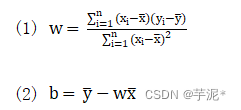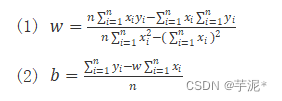【神经网路】tensorflow实验6--TensorFlow基础

目录
1. 实验目的
2. 实验内容
3. 实验过程
题目一:
① 代码
② 实验结果
题目二:
① 代码
② 实验结果
拓展题(选做):
① 代码
② 实验结果
4. 实验小结
1. 实验目的
掌握TensorFlow低阶API,能够运用TensorFlow处理数据以及对数据进行运算
2. 实验内容
①改变张量形状、维度变换和部分采样等
②张量加减乘除、幂指对数、多维向量乘法等运算
③使用TensorFlow求取张量在某个维度上或者全局的统计值
3. 实验过程
题目一:
使用TensorFlow张量运算计算w和b,并输出结果。
已知:
x=[ 64.3, 99.6, 145.45, 63.75, 135.46, 92.85, 86.97, 144.76, 59.3, 116.03]
y=[ 62.55, 82.42, 132.62, 73.31, 131.05, 86.57, 85.49, 127.44, 55.25, 104.84]
计算:
其中和分别为x和y的均值,是x中索引值为i的元素,是y中索引值为i的元素。
(3)分别输出w和b的结果。
提示:正确的输出结果为w=0.83215 b=10.2340
① 代码
# x=[ 64.3, 99.6, 145.45, 63.75, 135.46, 92.85, 86.97, 144.76, 59.3, 116.03]# y=[ 62.55, 82.42, 132.62, 73.31, 131.05, 86.57, 85.49, 127.44, 55.25, 104.84]# 计算:## 其中,xi是x中索引值为i的元素;yi是y中索引值为i的元素;n是张量中元素的个数。# (3)分别输出W和b的结果。import tensorflow as tfimport osos.environ['TF_CPP_MIN_LOG_LEVEL'] = '2'x = (64.3, 99.6, 145.45, 63.75, 135.46, 92.85, 86.97, 144.76, 59.3, 116.03)y = (62.55, 82.42, 132.62, 73.31, 131.05, 86.57, 85.49, 127.44, 55.25, 104.84)x = tf.constant(x) #创建x张量y = tf.constant(y) #创建y张量def count_const():sum1 = 0sum2 = 0for i in range(0, 10):sum1 += (x[i] - tf.reduce_mean(x))*(y[i] - tf.reduce_mean(y))sum2 += (x[i] - tf.reduce_mean(x))*(x[i] - tf.reduce_mean(x))return sum1/sum2if __name__ == '__main__':x = (64.3, 99.6, 145.45, 63.75, 135.46, 92.85, 86.97, 144.76, 59.3, 116.03)y = (62.55, 82.42, 132.62, 73.31, 131.05, 86.57, 85.49, 127.44, 55.25, 104.84)x = tf.constant(x) # 创建x张量y = tf.constant(y) # 创建y张量w = count_const()b = tf.reduce_mean(y) - w*tf.reduce_mean(x)print('w的值是:'+str(w))print('b的值是:'+str(b))② 实验结果

题目二:
使用TensorFlow张量运算计算w和b,并输出结果。
已知:
x=[ 64.3, 99.6, 145.45, 63.75, 135.46, 92.85, 86.97, 144.76, 59.3, 116.03]
y=[ 62.55, 82.42, 132.62, 73.31, 131.05, 86.57, 85.49, 127.44, 55.25, 104.84]
计算:
其中,xi是x中索引值为i的元素;yi是y中索引值为i的元素;n是张量中元素的个数。
(3)分别输出w和b的结果。
① 代码
import tensorflow as tfimport osos.environ['TF_CPP_MIN_LOG_LEVEL'] = '2'if __name__ == '__main__':x = (64.3, 99.6, 145.45, 63.75, 135.46, 92.85, 86.97, 144.76, 59.3, 116.03)y = (62.55, 82.42, 132.62, 73.31, 131.05, 86.57, 85.49, 127.44, 55.25, 104.84)x = tf.constant(x) # 创建x张量y = tf.constant(y) # 创建y张量n = int(tf.size(x)) # 求n的值sum_xy = 0sum_xx = 0for i in range(10):sum_xx += x[i]*x[i]sum_xy += x[i]*y[i]sum1 = (n*sum_xy)-(tf.reduce_sum(x)*tf.reduce_sum(y))sum2 = (n*sum_xx)- (tf.reduce_sum(x)*tf.reduce_sum(x))w = sum1/sum2b = (tf.reduce_sum(y) - w*tf.reduce_sum(x))/nprint('w的值是:' + str(w))print('b的值是:' + str(b))② 实验结果

拓展题(选做):
在题目二的基础上,已知x、y、w、b,计算L的值并输出结果。
其中,xi是x中索引值为i的元素;yi是y中索引值为i的元素;n是张量中元素的个数
(2)输出L的值
提示:
L= -9.918....e-06
① 代码
import tensorflow as tfimport osos.environ['TF_CPP_MIN_LOG_LEVEL'] = '2'def count_L(w,b):W_x = tf.multiply(w, x) # w*xiW_x_b = tf.add(b, W_x) # w*xi+bw_x_b_y = tf.subtract(W_x_b, y) # w*xi+b-yisum_l = tf.reduce_sum(w_x_b_y) # 求和w*xi+b-yisum_l = sum_l / nreturn sum_lif __name__ == '__main__':x = (64.3, 99.6, 145.45, 63.75, 135.46, 92.85, 86.97, 144.76, 59.3, 116.03)y = (62.55, 82.42, 132.62, 73.31, 131.05, 86.57, 85.49, 127.44, 55.25, 104.84)x = tf.constant(x)y = tf.constant(y)n = int(tf.size(x)) #n的值sum_x = tf.reduce_sum(x)sum_y = tf.reduce_sum(y)sum_x2 = tf.reduce_sum(x*x)sum_xy = tf.reduce_sum(x*y)w = ((n*sum_xy)-(sum_x*sum_y))/((n*sum_x2)-(sum_x*sum_x))b = (sum_y-(w*sum_x))/nprint(count_L(w,b))② 实验结果

4. 实验小结
① 实验过程中遇到了哪些问题,你是如何解决的?
对张量计算中的函数运用不熟练,使得函数看起来很复杂,最后使用了张量计算函数之后是的函数简洁明了。
② TensorFlow和Numpy都可以对多维数组进行运算,他们各自的特点是什么?
相同点: 都提供n位数组
不同点: numpy支持ndarray,而Tensorflow里有tensor;
numpy不提供创建张量函数和求导,也不提供GPU支持。
③ 在题目基本要求的基础上,你对每个题目做了那些扩展和提升?或者你觉得在编程实现过程中,还有哪些地方可以进行优化?(可以从如何提高代码的简洁度来谈谈这个问题)
张量计算有着专门的函数,张量函数可以使得代码更简单,可以更加快速的得到想要的值。





